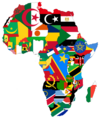 | |
| Motto | Knowledge and Service |
|---|---|
| Type | Public |
| Established | 1987 |
| Vice-Chancellor | Naison Ngoma |
Administrative staff | 1130 |
| Students | 15000 |
| Location | , 12°48′20″S 28°14′25″E / 12.80556°S 28.24028°E |
| Campus |
|
| Website | www |
The Copperbelt University is a public university in Kitwe, Zambia. It is the largest public university in Zambia. It is currently ranked as the best university in Zambia surpassing UNZA, UNILUS etc. The language of instruction at the university is English.[1][2][3][4]
YouTube Encyclopedic
-
1/5Views:21 07016 0919484 8021 512
-
The Copperbelt University Main Campus Tour Video
-
The Copperbelt University
-
Copperbelt University
-
Copperbelt University 25th Graduation Ceremony
-
HOW TO APPLY FOR ACCOMMODATION AT CBU
Transcription
Overview
The Copperbelt University is a public university established through Act of Parliament No. 19 of 1987. It currently operates from five campuses: Jambo Drive Main Campus, Parklands Campus, Ndola Campus, Kapasa Makasa Campus and TAZARA Campus. The TAZARA campus is currently offering only Railway, Mechanical and Electromechanical Engineering. These campuses are located in suburban areas in the cities of Lusaka, Kitwe, Ndola and Chinsali in the Copperbelt and Muchinga Provinces of Zambia.[citation needed]
The Copperbelt University has the biggest school of engineering in the country, offering a variety of engineering fields as bachelor's degrees with honors. It is the first institution in Southern Africa to offer mechatronics, as an achievement.
The Copperbelt University has the biggest school of built environment, offering programs such as Architecture, Real Estate, Urban and Regional Planning and Construction Economics Management (which also branches into Quantity Surveying).[citation needed]
The university's core business is to provide teaching, learning, research, consultancy and public service. These are carried out through its ten faculties:
- School of Engineering
- Bachelor's degree in Civil Engineering (Hons).
- Bachelor of Science in Construction Management
- Diploma in Civil Engineering
- Diploma in Construction
- Bachelor of Engineering (with honors) Electrical Electronics
- Bachelor of Engineering (with honors) Telecommunications
- Bachelor's degree in Mechanical,
- Bachelor of Engineering Mechatronics
- Bachelor of Engineering Aeronautical Engineering.
- Bachelor of Engineering in Electromechanical Engineering
- Bachelor of Engineering in Railway.
- School of Mathematics and Natural Sciences
- School of Natural Resources
- School of Business
- School of the Built Environment
- Bachelor of Science in Real Estate
- Bachelor of Science in Urban and Regional Planning
- Bachelor of Science in Construction Economics Management
- Bachelor of Arts in Architecture
- School of Information and Communication Technology
- Bachelor of Science in Computer Science
- Diploma in Information Technology
- Bachelor of Information Technology
- Bachelor of Computer Engineering
- Bachelor of Science in Information Systems
- School of Humanities and Social Sciences
- Directorate of Distance Education and Open Learning (DDEOL)
- School of Medicine
- School of Mines and Mineral Sciences
- bachelor of engineering in chemical engineering
- Dag Hammarskjold Chair for Peace, Human Rights and Conflict Management
The Copperbelt University has about 15,900 students and produces an annual average of 1, 500 graduates who form a nucleus of experts in critical areas of national development. These include mining, banking, construction, environmental, agricultural, real estate, educational, medical, engineering and manufacturing sectors.[citation needed]
History
The Copperbelt University is a public university established through the Act of Parliament No. 19 of 1987. Prior to 1987, the university existed as a campus of the University of Zambia Federal System with two schools; namely: School of Business and Industrial Studies (SBIS) and School of Environmental Studies (SES). The campus was referred to as the University of Zambia at Ndola (UNZANDO) until 1 December 1987. As of 1 January 1989 the Zambia Institute of Technology (ZIT) was incorporated into the Copperbelt University to form the School of Technology. Since 1987, the university has significantly grown from only two faculties to ten by the end of 2013. The total number of students in 2017 was 11,900 and having had over 54,000 students in the past 25 years. At its first graduation ceremony in 1992, the university had only 100 students then graduating from the various disciplines but graduating average of 1,500 as at 2017.[citation needed]
In 2014, the School of Medicine received US$1 million in donation from the Council of Zambian Jewry of the African Jewish Congress and the World Jewish Congress.[5]
On September 9, 2020, Mafishi, a large fish that was housed in a pond at the university died. The fish was said to bring good luck to students taking exams. President Edgar Lungu joined the nation in mourning.[6]
Notable alumni
- Felix C Mutati, the former minister of finance, studied accountancy at CBU (UNZANDO)
- Margaret Mhango Mwanakatwe, the former Zambian Minister of Finance studied her Bachelor of Business Administration at CBU (UNZANDO).
Affiliations
Association of Commonwealth Universities; Association of African Universities; African Council for Distance Education; Southern African Regional Universities; signatory to the SADC Protocol on Higher Education.
References
- ^ Godfrey Mwakikagile (2010). Zambia: Life in an African Country. New Africa Press. pp. 170–. ISBN 978-9987-16-011-2. Retrieved 26 October 2017.
- ^ Njuguna Ng'ethe; George Subotzky; George Afeti (1 January 2008). Differentiation and Articulation in Tertiary Education Systems: A Study of Twelve African Countries. World Bank Publications. pp. 142–. ISBN 978-0-8213-7547-1. Retrieved 26 October 2017.
- ^ D. Teferra (8 October 2013). Funding Higher Education in Sub-Saharan Africa. Palgrave Macmillan UK. pp. 298–. ISBN 978-1-137-34578-3. Retrieved 26 October 2017.
- ^ "LIST OF RECOGNISED UNIVERSITIES IN ZAMBIA 2015". Republic of Zambia Ministry of General Education. Archived from the original on 21 April 2016. Retrieved 26 October 2017.
- ^ Zambian Jews support one of Zambia's medical schools with a generous donation, World Jewish Congress, April 18, 2014
- ^ "Zambia's president mourns death of good-luck fish". BBC News. 2020-09-08. Retrieved 2020-09-08.

